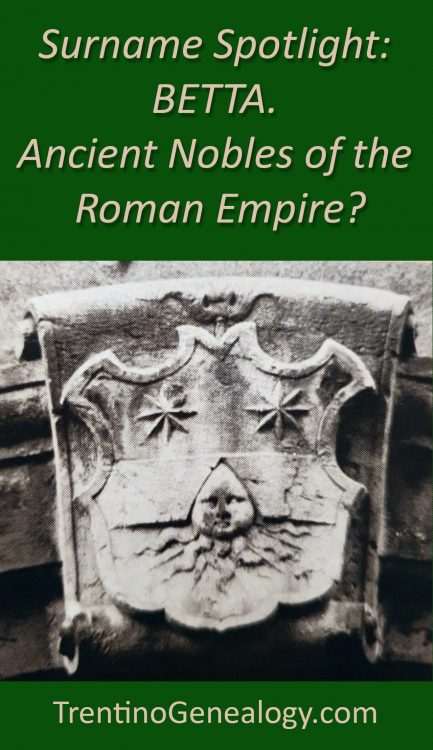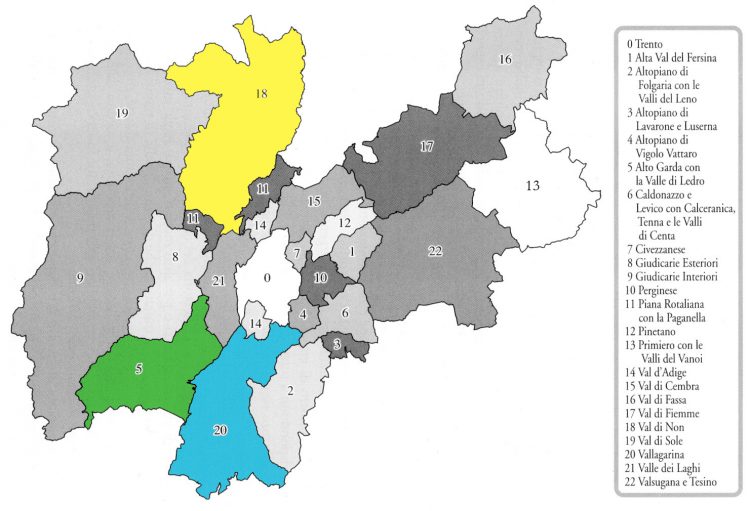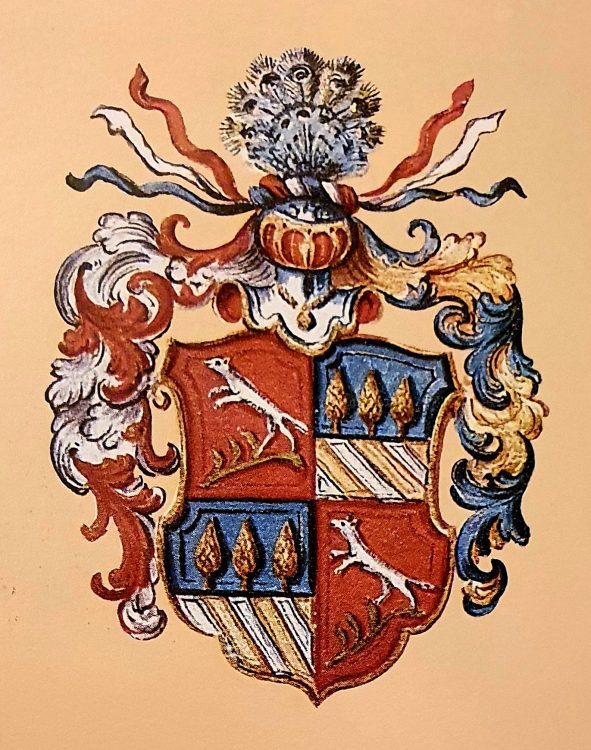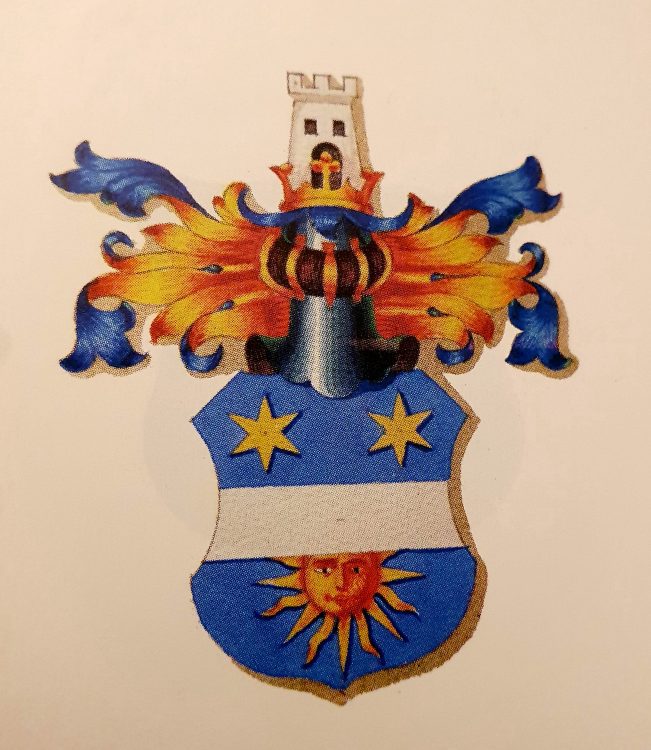 Genealogist Lynn Serafinn explores the history of the noble Betta family of Trentino, including its claims to Spanish origins, and ancient ‘patrician’ nobility from time of the Roman Empire.
Genealogist Lynn Serafinn explores the history of the noble Betta family of Trentino, including its claims to Spanish origins, and ancient ‘patrician’ nobility from time of the Roman Empire.
If you’ve been following this blog, you’ll know that I said I would write the next article on the parish of Revò in Val di Non, as part of my continuing series on Trentino Valleys.
Well, I decided to take a short detour. One of my ongoing projects is a book (more likely a multi-volume set) on the surnames of Trentino, which I’ve been working on for a few years, and which I’ve called Guide to Trentino Surnames for Genealogists and Family Historians. With any luck, I’ll have at least the first volume of it out in a few years. In the meantime, I’ve created a ‘surname database’ on this website, with many (but not all) shortened versions of the entries I’ve written for the book.
Anyway, when doing some research for the Revò article this weekend, I started writing up some histories of some of the local surnames. The history for one particular surname – Betta – became so substantial, I thought it deserved to be shared in a blog post, especially as this surname crosses over into many other parts of the province. Also, the family has a unique ‘claim to fame’, which I think many of you might find interesting.
Linguistic Origins of the Surname
In his Guida ai Cognome del Trentino, linguistic historian Aldo Bertoluzza says this surname is either derived from the male name ‘Betto’, which is a short form of the name ‘Benedetto’, coming from the Latin word Benedictus, which means a person who is blessed. Alternatively, he says it may also come from the female name ‘Elisabetta’ (although the original form of the name was ‘Elisheba’), which he says means ‘my God is fullness’.
As with most patronymic/matronymic surnames (i.e. based on the name of a patriarch or matriarch), there are many other surnames based on this root ‘Bett-’. But for this article, we will focus solely on the form that appears as ‘Betta’, although occasionally you might also see it spelled with only one ‘t’ (Beta).
Geographic Origins of the Family
While all historians seem to agree the Betta came from outside the province of Trentino, and were most likely of ancient nobility, there is much disagreement regarding their precise origins, the nature of their nobility and their movements prior to the 1400s.
In his 3-volume work, Dizionario Storico-Blasonico delle Famiglie Nobili E Notabili Italiane Estinte E Fiorenti, historian Giovanni Battista di Crollalanza says the Betta of Trentino were originally from Spain, but relocated to Trentino sometime in the last decades of 11th century. The story goes that the Betta were loyal to Prince Garcia, who claimed the title of King of Galicia and Portugal in 1071. Just a year later, two of Garcia’s brothers attacked him, ultimately resulting in Garcia’s imprisonment until his death in 1090. Upon Garcia’s imprisonment, fearing they would be tried as traitors (and probably executed) by the new leaders, the Betta fled their native homeland taking refuge in Trentino.
This tale has been the Betta family lore for many centuries. Colourful as it is, many historians do not believe it is true. Tabarelli de Fatis (Stemmi e Notizie di Famiglie Trentine) says the link to Spain is not documented (although few things are that far back), and they were more likely to have come from either Lombardia or the province of Verona. Author Gian Maria Rauzi (Araldica Tridentina) cites historian Quintillo Perini (1865-1942), who believes the Betta came to Trentino from Milan (in Lombardia). However, none of these authors cite any documentation or suggest any concrete evidence for these theories either.
Arrival, Migration and Branching Out
Precisely where the Betta entered the province, and the path they took when they settled there is also disputed. Essentially, the only thing historians seem to agree on is that the Betta came from someplace outside the province of Trentino, arriving somewhere in the province no later than the mid-1300s, and then spreading out to diverse places in the province.
Crollalanza says they originally took refuge in Val Lagarina. Although he doesn’t specify, the evidence indicates they were in Tierno, which is a frazione in Mori in that valley. In support of this theory, Bertoluzza cites a record that mentions an Antonio son of Guglielmo Betta in Val Lagarina in 1344 (the earliest mention I’ve seen cited for a Betta).
Tabarelli de Fatis and Rauzi believe the Betta first arrived in Arco, where their surname appears in records from the beginning of the 1400s, and that they expanded to Val Lagarina – specifically Tierno – from there. Bertoluzza cites a record dated 1411 that mentions a Guglielmo Betta of Tierno. From Tierno, they believe, various branches of the family then expanded outwards to other parts of Val Lagarina, such as Brentonico, Chizzola (a frazione of Ala), and Rovereto. Although they don’t mention it, based on notary records, at least one Betta family from this area settled in Riva del Garda (which is near Arco) by the early 1500s.
Regardless of whether the starting point in Trentino was Tierno or Arco, what is less disputed by historians is that, by the late 1400s, one of the Arco branches moved north, to various points in Val di Non, namely Cles and Revò, and eventually to Castel Malgolo. Apparently, there was a Stefano Betta of Cloz (near Revò) whose name appeared in the catalogue of noble gentry of Valli di Non and di Sole in 1529, but haven’t seen any other mention of the Betta living in Cloz.
Based on this, most historians today see the Betta as being split into two primary lines: one in Val di Non and one in Val Lagarina, especially in the area around Rovereto. The Arco line itself continued throughout the centuries, but not as prolifically as in these other places, and seems to have died out by the end of the 19th century. If you look on Nati in Trentino, you will find 1,349 Betta babies born in Trentino between the years 1815-1923, in most of the above-mentioned places as well as in Aldeno, Arco, Baselga, Bresimo, Caldes, Cavalese, Cis, Meano, Mezzocorona, Castello-Molina di Fiemme, Pergine, Preghena, Fondo, Stenico, Storo, Tenno, Tione, Vervò, and the city of Trento. I will briefly mention the Betta of Stenico in Val Giudicarie later in this article. In my own research, I have also found the surname Betta in Vezzano back to the mid-1600s, as well as in Tenno (again, near Arco) in the mid-1700s.
Below is a map where I have highlighted:
- Alto Garda (number 5) in green, which is where places like Arco, Riva and Tenno are located.
- Val Lagarina (number 20) in blue, which is where places like Tierno in Mori, Rovereto, Brentonico and Ala are located.
- Val di Non (number 18) in yellow, which is where places like Revò, Cles and Castel Malgolo are located, as well as Marcena in Val di Rumo, which I will discuss shortly.

Click on image to see it larger
Looking at this map, it seems most likely that all the Betta who are in the southern part of the province are from the original Val Lagarina and/or Arco lines, whilst those in the north are probably descended from the branch that shifted to Revò. But I’ve learned over the years that ‘most likely’ isn’t always ‘true’.
Regarding the dispute over whether the Betta started out in Tierno in Val Lagarina or in Arco, I think the documentation seems to lean to the former. Notary documents and names of priests with the Betta surname seem to go back at least a century earlier in Val Lagarina than those in Arco. Of course, that is not ‘proof’ on its own, as it may just be that more records from Tierno have survived than those from Arco.
Betta Notaries
Traditionally, the Betta were a family of notaries. In Trentino (and indeed all of Italy), a notary is kind of like a contract lawyer. He was responsible for writing every legal document for the comune – Last Wills and Testaments, land sale agreements, legal disputes, dowry agreements, court cases, ‘Carte di Regola’ (charters of local laws), etc. They were educated, highly prestigious and essential to the functioning of the community. If you are unfamiliar with this occupation, you might wish to read my article ‘Was One of Your Trentino Ancestors a Notary?’.
Priest and historian P. Remo Stenico has compiled a PDF book of Trentino notaries throughout the centuries. Among them, he lists over 30 Betta notaries, a substantial number for any single family. His research is based on surviving documents, so it is certainly likely there were more notaries before the dates he cites.
The earliest Betta notary he lists is Antonio Betta of Tierno in Val Lagarina, who appears in records as early as 1460, where he is described as ‘Antonio, son of the late Giovanni, son of the late Guglielmo Betta of Tierno’. This would place his grandfather’s birth sometime in the late 1300s. Looking at the family names, I would hazard a guess that they are descended form the ‘Antonio, son of Guglielmo’ cited by Bertoluzza (see above).
Less than a generation later, we find a notary named Giovanni Betta of Arco, whose name appears in records as early as 1475. Giovanni had a son name Bonifacio who followed in his father’s professional footsteps, appearing in notary documents as early as 1504. This Bonifacio is a significant figure, as he is actually the founder of the Betta line in Val di Non.
Brief Mention – Betta of Val di Fiemme
Before we move on to the Betta of Val di Non, I would like to briefly mention that we find Betta notaries present in Val di Fiemme at the beginning of the 1600s. The earliest I have found is the notary named Pietro Betta, son of Giovanni Betta, who was active at least between the years 1604-1625. Originally from Varena but living in Cavalese, Pietro also served as the Vicario of Castello di Fiemme (n.b.: ‘vicario’ refers to a secular role, not a priest). Pietro’s son, Orazio Betta of Cavalese, followed in his father’s footsteps and was active as a notary at least between 1622-1636.
The surname still flourishes in Fiemme today, mainly in Cavalese, Castello and Molina. I do not yet know if or how they may be related to the other lines I will discuss in this article.
Article continues below…
Bonifacio Betta – From Arco to Val di Non
Author Pietro Micheli tells us that the name Bonifacio Betta appears in diploma of nobility in Marcena archives, dated 13 July 1495. Later, in 1525, this same Bonifacio was granted a title of rural nobility for his loyalty to the bishop of Trento, Bernardo Cles, during the Guerra Rustica (although, apparently, he didn’t engage in any of the military action).
This man is the same Bonifacio Betta of Arco who was cited as a notary twenty years earlier. By comparing various documents, it seems that Bonifacio maintained his home base in Arco, but was simultaneously busy acquiring a lot of land in Revò and Val di Rumo. Micheli lists a number of legal disputes over the rights to various resources and land borders, especially with the municipality of Rumo.
Ancient Nobility and ‘Caesarean Privilege’
We see these disputes continued into the next generation, when the comune of Rumo claimed that Signore Giovanni Betta of Revò (not Bonifacio’s son Giovanni) possessed most of the assets/land in municipality of Rumo, but that he was not paying any of the collections for said lands that were due to the Bishop of Trento. Giovanni Betta responded that he was ‘not obligated’ to pay those collections, because he was not ordinary ‘rural nobility’, but rather ‘superior’ or ‘ancient’ nobility, going back to time immemorial. In a document dated 1576 (found in the Marcena archives), he claimed he had ancient privileges from his ancestors, whereby his predecessors, successors and heirs and he himself were – and will always be – exempt from paying collections/taxes.
Half a century later, a similar dispute took place between a Bartolomeo Betta and the community of Revò. But this time, Bartolomeo appealed directly to the Bishop, and on 13 January 1637, he presented the leaders in Revò with a document from the Castello del Buonconsiglio stating that the family were granted the privilege of immunity from payments due to the Bishops of Trento, by virtue of their ‘Caesarean privilege’.
‘Caesarean privilege’ is a term indicating the family were believed to be ‘ancient’ nobility, allegedly (or at least ‘officially’) dating back to the time of the Roman empire.
Just as their claim to Spanish origins cannot be documented, there is also no ‘paper trail’ to confirm the nobility of the Betta family dated back to the time of the Caesars. True or not, they certainly were successful in persuading Bishops and Emperors of their veracity. Indeed, the Betta of Revò acquired the Bishop’s Palazzo – adorned with the stemma of Cardinal Cles – which still stands in the western part of the village, albeit in disrepair.
The Sons of Bonifacio Betta
We know Bonifacio had at least two sons, both of whom are historically important.
Born in Arco in 1499, Bonifacio’s son Giovanni Betta was a medical doctor who went on to become the Bishop of Trieste from 1560, until his death on 15 April 1565.
Another son named Pantaleone became the patriarch of another branch of the family called ‘Betta di Malgolo’, which I will discuss next.
Pantaleone Betta, Founder of the Betta di Malgolo
In 1555, Pantaleone Betta, son of Bonifacio, married Bona Concini of Casez. His new bride was the heiress of Castel Malgolo, and the couple settled there. Built sometime before 1342, and originally owned by the Lords of Coredo, the castle is in the locality of Malgolo, which is part of the municipality of Romeno. Today it is a private home.
From this couple came the ‘Betta di Malgolo’ line, upon whom many noble titles were conferred in the subsequent centuries. On 11 June 1645, Emperor Carlo V granted nobility of the Holy Roman Empire to Giovanni Betta di Castel Malgolo, a medical doctor. Two Prince-Bishops – Carlo Emanuele Madruzzo and Giovanni Michele Spaur – confirmed the family’s noble titles in 1637 and 1697, respectively.
In keeping with the family profession, the line produced many notaries, at least three of which are listed in P. Remo Stenico’s book of notaries.
Here is the stemma (coat-of-arms) for the Betta di Castel Malgolo as it appears in the book Araldica Tridentina by Gian Maria Rauzi:

ROVERETO – Betta della Beta
Tabarelli de Fatis says this line came to Rovereto (from Tierno, via Brentonico), where their title of ancient ‘patrician’ nobility was recorded in 1517. He tells us this line went extinct with Ferdinando Vincenzo Betta in 1878. Their stemma is found at the University School of Bologna, for Felice Leonardo, laureate in 1653.
ROVERETO – Betta del Toldo
Tabarelli de Fatis says this line may have started in Folgaria (not far from Rovereto). We do know that, in 1537, they were awarded feudal lands by the Prince-Bishop in Rovereto, Lizzan and Lizzanella.
On 18 Jan 1556, their ancient stemma was confirmed by Emperor Ferdinand I to Luigi Betta. This stemma also appears on the façade of the palazzo in Rovereto that bears their name (see title image at the top of this article). Later, the stemma was embellished (see below), but the main part of the stemma remained the same.
On 27 March 1564, this same emperor (Ferdinando I) also awarded Luigi the title of Tyrolean Nobility. Rauzi says this Betta line was elevated to the rank of Barons of the Holy Roman Empire by the Duke of Bavaria in 1790.
Here is the embellished stemma of the Betta del Toldo family as it appears in the book Stemmi e Notizie di Famiglie Trentine (Tabarelli de Fatis; Borrelli):

VAL GIUDICARIE – Betta of Stenico
In his 1993 article ‘Le famiglie nobili e notabili delle Giudicarie Esteriori’, historian Carlo Alberto Onorati includes the Betta of Stenico in his discussion of noble families. He admits that he didn’t know whether the Betta of Stenico came from the Betta of Rovereto, or one the Nones families. I have yet to find any other author even mention this line.
The clearest evidence we have of this family in Stenico is their presence as notaries. P. Remo Stenico lists five of them, the earliest being a Francesco Betta of Stenico, who appears in documents as far back as 1656.
Onorati offers no information about the specifics of their nobility, but says the Betta of Stenico retained the rank of Lords until the end of the 1800s, whereas most lesser nobility lost their titles and privileges as a result of the Napoleonic invasions.
Betta Artisans
In their book Artisti Trentini e Artisti Che Operarono Nel Trentino, authors Weber and Rasmo mention two Betta artisans:
- Giovanni Maria Betta of Cavalese (1702-1775). Carver/engraver. In 1758, he gilded four reliquaries for the church of Panchià in Val di Fiemme, and also engraved the sacristy cabinets for the church in Valfloriana (also Val di Fiemme), signing them ‘Giovanni Maria Betta fecit anno 1772’.
- Giuseppe Betta of Cavalese (died 1773). In 1730, he made a tabernacle in the church of Sanzeno to contain the relics of the Holy Cross. He engraved another tabernacle for the church at Tesero, and a third one for the main altar of the church of the Franciscans in Cavalese.
Betta Priests
Similar to his book on notaries, P. Remo Stenico book Sacerdoti della Diocesi di Trento dalla sua Esistenza Fino all’Anno 2000, is a compilation of names of priests who served in the Diocese of Trento throughout the centuries. In that book, he lists more than 50 priests with the Betta surname.
I’ve already mentioned Bonifacio Betta’s son Giovanni (1499-1565), who served as the Bishop of Trieste. While he was born in Arco, the earliest Betta priests Stenico mentions are all from Tierno, most likely born a century before Giovanni in the late 1300s or early 1400s.
Other Betta of Note
Bertoluzza lists many people (well…actually all men) of note who had the surname Betta. Here are a few he mentions:
- Lodovico Betta of Arco (1500s). Latin poet.
- Francesco Betta dal Toldo of Rovereto (1526-1599). Legal consultant, expert.
- Felice Giuseppe Betta of Rovereto (ca 1701-1765). Historian and scholar.
- Ferdinando Betta of Brentonico (1700s-1800s). Lawyer and translator.
- Edoardo Francesco de Betta (1822-1896) of Malgolo, politician, zoologist, natural sciences.
- Nino Beta of Rovereto (1909-1991). Writer, professor, recipient of gold medal for culture.
- Bruno Betta of Rovereto (1908-1997). Antifascist, writer, professor.
Closing thoughts
We all like a little bit of ‘glamour’ in our family history. This is why tales of ‘exotic’ Spanish origins, dramatic flights from one’s homeland 1,000 years ago, and ancient nobility dating back to the Roman Empire can be awfully alluring – and enduring – when we construct our family histories. But as a genealogist, I feel it is my responsibility to present these to you as theories for your consideration, but not ironclad facts. Somehow, when reading the accounts of all the legal disputes back in the 1500s, I get the impression those Betta notaries were pretty good ‘talkers’ (not unlike courtroom lawyers today), and they were able to convince people of influence (such as the Prince-Bishops) of their ancestral lineage, which may or may not have been true.
Just because a certain version of a story has been repeated many times over, does not prove its veracity. But equally, a lack of tangible proof does not necessarily make something untrue.
But one thing is absolutely true: The Betta family has a colourful story. And, in truth, the story itself (even if it’s completely made up) is also part of their history, as it has become part of the family identity.
And if it’s part of YOUR family story, it really is up to you to choose the version you wish to own, and pass on to future generations.
Coming Up…
Next time, as promised, we’ll move on to the parish of REVÒ in Val di Non, the home parish of so many of my clients’ ancestors, and a place I have researched extensively over my years as a genealogist.
In that article (or perhaps in the subsequent one, if it gets too long!), I’ll also touch upon Romallo, Cagnò, Tregiovo, and Marcena di Rumo, which historically were part of the parish of Revò.
I hope you’ll join me for that. To be sure to receive the next article in this series ‘Trentino Valleys, Parishes and People: A Guide for Genealogists’ – and ALL future articles from Trentino Genealogy – just subscribe to this blog using the form below.
Until then…

Warm wishes,
Lynn Serafinn
26 October 2020
P.S. As you probably know, my spring and summer trips to Trento was cancelled due to COVID-19 lockdowns. I am also not sure when I will be back in Trento. I was hoping to go in November 2020, but now it might be a bit later, after the New Year. There is no way to know for sure right now.
However, I do have resources to do a fair bit of research for many clients from home, and I will have some openings for a few new client projects starting in December 2020.
If you would like to book a time to discuss having me do research for you, I invite you to read my ‘Genealogy Services’ page, and then drop me a line using the Contact form on this site. Then, we can set up a free 30-minute chat to discuss your project.
Join our Trentino Genealogy Group on Facebook: http://facebook.com/groups/TrentinoGenealogy
Lynn on Twitter: http://twitter.com/LynnSerafinn
View my Santa Croce del Bleggio Family Tree on Ancestry:
https://trentinogenealogy.com/my-tree/
REFERENCES
ANZILOTTI, Giulia Mastrelli. 2003. Toponomastica Trentina: I Nomi delle Località Abitate. Trento: Provincia Autonoma di Trento, Servizio Beni librari e archivistici.
BERTOLUZZA, Aldo. 1998. Guida ai Cognomi del Trentino. Trento: Società Iniziative Editoriali (S.R.L.).
CROLLALANZA (di), G.B. 1886. Dizionario Storico-Blasonico delle Famiglie Nobili E Notabili Italiane Estinte E Fiorenti. 3 volumes. Bologna: Arnaldo Forni Editore.
MICHELI, Pietro. 1985. Carta della Regola della Magnifica Comunità di Revò. Trento: Grafiche Artigianelli.
ONORATI, Carlo Alberto. 1993. ‘Le famiglie nobili e notabili delle Giudicarie Esteriori’. Judicaria, January-April 1993, n. 22. p 8-46. Tione: Centro Studi Judicaria.
RAUZI, Gian Maria. Araldica Tridentina: stemmi e famiglie del Trentino. 1987. Trento: Grafiche Artigianelli.
SERAFINN, Lynn. 2018. ‘Was One of Your Trentino Ancestors a Notary?’ Published on 26 May 2018 at https://trentinogenealogy.com/2018/05/trentino-ancestor-notary/
STENICO, P. Remo. 1999. Notai Che Operarono Nel Trentino dall’Anno 845. Trento: Biblioteca San Bernardino. Can be downloaded for free in PDF format from http://www.db.ofmtn.pcn.net/ofmtn/files/biblioteca/Notai.pdf
STENICO, P. Remo. 2000. Sacerdoti della Diocesi di Trento dalla sua Esistenza Fino all’Anno 2000. Can be downloaded for free in PDF format from http://www.db.ofmtn.pcn.net/ofmtn/files/biblioteca/Preti-Indice-Preti.pdf
TABARELLI DE FATIS, Gianmaria; BORRELLI, Luciano. 2005. Stemmi e Notizie di Famiglie Trentine. Trento: Società di Studi Trentini di Scienze Storiche.
WEBER, Simone; RASMO, Nicolò. 1977. Artisti Trentini e Artisti Che Operarono Nel Trentino. Trento: Monauni. Originally published in 1933, this is the 2nd edition.

Fascinating!
Thanks, Eileen! I am glad you enjoyed it. 🙂
Hi there. As a Betta who did not grow up in the region this is super fascinating. Thank you so much for the level of detail. I also feel like I missed my calling as a notery now
I have a client who is a contract lawyer. When he found out how many of his ancestors were notaries, he felt like he had answered some kind of ancestral calling.
My last name is Betta and I am second generation Tyrolean. My grandfather immigrated to the coal mining area of Hazleton Pennsylvania where there is The only Tyrolean Catholic Church in the US, I think. I found your article to be very interesting to say the least! Thank you so much For your research on my surname.
Thanks for reading and for leaving the nice comment, Shirley! I am glad you found your surname here. Many people refer to the church in Hazleton as the only Tyrolean Catholic church in the US, but I also know there is (or at least was) Holy Cross in Brandy Camp, which was founded by Trentini, mostly from Bleggio in Val Giudicarie (their home parish in Bleggio is Santa Croce, which means Holy Cross). If you are not already a member of our Facebook group, I do welcome you to join us at https://www.facebook.com/groups/TrentinoGenealogy/. You might just meet some new cousins there.
Warm wishes,
Lynn Serafinn
Thank You so much for the marvellous article of the Betta families. It shows me history continuing, so I’m working as a lawyer and biographer , my elder son is scientist of biology at the Vienna University.
Warm wishes
Michael Waschk